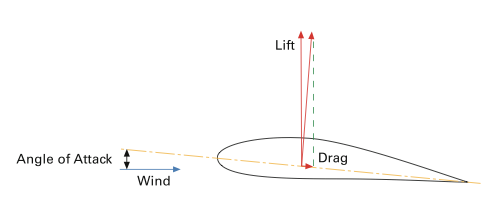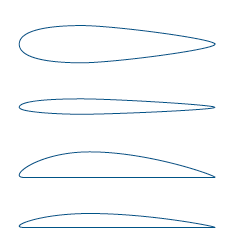Wind Turbines
Assignment
Create a mechanism that will spin in the wind. Attach the mechanism to a low RPM motor. Attach the leads of the motor to an LED. As the blades spin, the LED should light up.
This is derived from
larsonmattr's
Mini - Wind Turbine
Download these files:
holder-rev2
wing.dxf
blade.scad
Converting kinetic energy into electrical energy.
Kinetic energy of wind turns the blades which drives
a generator that converts the kinetic energy
to electromagnetic energy.
The current is used to do work, while voltage (the resulting force after overcoming resistance) is the energy required to drive the flow of the current.
A Turbine
The basic concept is simple. A framework or support column holds up a large wheel or turbine blades that looks like a fan or airplane propeller. The angled blades catch passing winds and deflect some of the wind's energy, which pushes the blades around, turning a central shaft. The shaft can be connected via gears or belts to machinery on the ground or in a nearby structure. Alternatively, the shaft can be connected directly to a generator that produces electricity, which is then transmitted.
Blades
Blades of a windmill spin because of two principles:
- Newton's Third Law—For every action there is an equal and opposite reaction. So when the wind hits the blade, the blade is pushed. If the blade is at a certain angle, the wind is deflected at an opposite angle, which pushes the blades
away from the deflected wind. You can see this in action with the flat blade. If you push the blade it will will move in the direction away from your finger.
- The Bernoulli Effect—Faster moving air has lower pressure.
Wind turbines are cambered so that the air molecules moving around the blade travel faster on the downwind side than on the upwind side. This shape is like a teardrop. The downwind side is curved, while the upwind side is almost flat.
Air moves faster on the curved, downwind side of the blade so there is less pressure on this side of the blade. The difference in pressure on the other side of the blade causes the blade to be lifted toward the curve of the airfoil.
Experiment:
- Take two pieces of paper
- Fold them in half
- Unfold them and put them together so that the folds you made line up but the creases should be on the outside
- Blow between the papers
- Did it match your expectations
The speed of the air is higher between the two pieces of paper than outside the papers. Higher velocity leads to a lower pressure between the sheets.
How blades capture wind power
Wind turbine blades work by generating lift with their shape. The more curved side generates low air pressures while high pressure air pushes on the other side of the airfoil. The net result is a lift force perpendicular to the direction of flow of the air.
 Lift and Drag Vectors from WE Handbook- 2- Aerodynamics and Loads
Lift and Drag Vectors from WE Handbook- 2- Aerodynamics and Loads
The lift force increases as the blade is turned to present itself at a greater angle to the wind. This is called the
angle of attack. At large angles of attack the blade stalls and the lift decreases again. When it comes to generating the maximum lift, there is an optimum angle of attack.
Another force also exists. This is called
drag. This force is parallel to the wind flow, and also increases with
angle of attack. If the airfoil shape is good, the lift force is much bigger than the drag. But at very high angles of attack, the drag will increase dramatically. When the angle is slightly less than the maximum lift angle, the blade will reach its maximum lift/drag ratio. The best operating point will be between these two angles.
The blade's own movement through the air means that the wind is blowing from
a different angle. This is called
apparent wind. The apparent wind is stronger than the true wind but its angle is less favorable: it rotates the angles of the lift and drag to reduce the effect of lift force pulling the blade round and increases the effect of drag slowing it down. So, to maintain a good angle of attack, your blade must be turned further from the true wind angle.
The closer to the tip of the blade you get, the faster the blade is moving through the air and the greater the apparent wind angle is. Therefore the blade needs to be turned further at the tips than at the root. Your blade must be built with a twist along its length. Typically the twist is around 10-20° from root to tip.
In general the best lift/drag characteristics are obtained by a blade that is fairly thin.
Length: The blade length determines how much wind power can be captured.
Aerodynamic Section: The blades have an aerodynamic profile in their cross section to create lift and rotate the turbine.
Planform Shape: The planform shape gets narrower towards the tip of the blade to maintain a constant slowing effect across the swept area. This ensures that none of the air leaves the turbine too slowly (causing turbulence), yet none is allowed to pass through too fast (which would represent wasted energy).
Airfoil Thickness: The thickness increases towards the root to take the structural loads, in particular the bending moments. If loads weren't important then the section thickness/chord ratio would be about 10-15% along the whole length.
Blade Twist: To maintain optimum angle of attack of the blade section to the wind, it must be twisted along its length.
Blade Number and Rotational Speed: Typically three blades.
Pitch Control:
Because the wind power varies so greatly (with the cube of wind speed), the turbine must be able to generate power in light winds and withstand the loads in much stronger winds. Therefore, above the optimum wind speed, the blades are typically pitched either into the wind (feathering) or away from the wind (active stall) to reduce the generated power and regulate the loads.
Vocabulary
Amperage A measure of the flow rate of electrical current that is available.
Amps - Watts/Volts.
Blade Pitch Angle of the blades with respect to the plane of rotation. (Blades
perpendicular to the oncoming wind would be 0 degrees. Blades parallel to the
wind would be 90 degrees).
Drag In a wind turbine also called wind resistance. Friction of the blades
against air molecules as they rotate. Drag works against the rotation of the
blades causing them to slow down.
Forces -
Forces are the pushes and pulls in different directions. The direction and the strength of the force will be dependent on the strength and direction of all of the forces created by the forces added together. Scientists and engineers refer to this as the "sum of all the forces."
Lift A force experienced by the blades that is perpendicular to the oncoming
flow of air. Lift is a force working to speed up the rotation of the blades.
Multimeter An electronic instrument that can measure voltage, current, and
resistance.
PowerThe rate at which energy changes form from one form to another, or
the rate at which work is done
Voltage The electrical pressure that drives electric current. Voltage is a
convenient way of measuring the ability to do electrical work. Volts = Watts/Amps
Vectors -
In science, engineering, and mathematics, forces are a special type of quantity called a vector. Vectors have a magnitude (strength or size) and direction. When you add forces you are really adding both the magnitude (strength) of the force and its direction. Which way will a force move? You need to add both the magnitudes and directions of all the forces together.
Wattage A unit of measure for power, or how fast energy is used. One watt
of power is equal to one ampere (a measure of electric current) moving at one
volt (a measure of electrical force). One watt is equivalent to one joule of
electrical energy per second. Watts = Volts x Amps.

